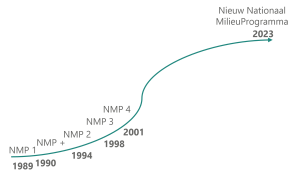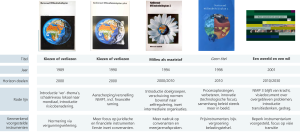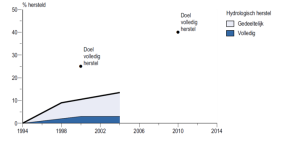An environmental policy with surprising foresight
After 20 years of no central environmental policy, the Ministry of Infrastructure and Water Management is taking back the reins with a new Environmental Policy Program. From 1970 to 2000, the Netherlands was the European leader, but in the years since then, it has gone into a slump. What can we learn from the heyday of Dutch environmental policy? Rebel draws lessons from the National Environmental Policy Plans for the new Program.
The rise and fall of environmental policy
In the late 1980s, when the realization dawns that environmental pollution and climate change are long-term problems with great consequences, the first comprehensive environmental policy comes around the corner. The National Environmental Policy Plan (NEP) “Choose or Lose” is presented in 1989 in response to the RIVM’s worrying and startling report “Zorgen voor morgen” (Caring for Tomorrow). A groundbreaking step, the environment gets an important place on the political and social agenda. This Dutch policy is also followed with interest internationally. A new National Environmental Policy Plan was published every four years until 2001.

Figure: environmental policy over time
Since 2001, many thematic policies have been implemented that are directly related to the environment: agriculture, mobility, climate, water, forests, and industry. Steps have been taken in mobility and energy transition has taken off. But major concerns remain regarding nitrogen, water quality, biodiversity, and air quality. New scientific insights (e.g. on carcinogenic properties of substances) lead to the need to formulate additional policies. A better environment cannot be achieved only on separate themes – such as nitrogen, plastics as well as water quality. Waterbed effects, spatial limitations in the Netherlands and the connection between natural processes in water, soil, and air lead to the need for an integrated approach to the environment as well. Hence the need for a new National Environmental Program, which the Ministry of Infrastructure and Water Management is currently working on.
The challenge
To learn from the successes and setbacks of previous environmental policies, Rebel was asked by the Ministry of Infrastructure and Water Management to draw lessons from previous NEPs over two months. What has become of the plans from the NEPs and what were the success and failure factors? Because of the short lead time, Rebel’s analysis is not comprehensive or complete, but it draws lessons for the future with an eye to context.

Figure: characteristics of different environmental policies
Rebel, therefore, focused primarily on the effectiveness of the instruments that were deployed. Which instruments contributed to whether or not the goals were met? What factors influenced this? Instruments analyzed include covenants, economic incentives, and standardization. The instruments were analyzed in the context of several themes, such as nitrogen dioxide emissions, desiccation, and waste treatment. The question was always asked: have the set goals been achieved? Did the instruments contribute to this and what were important success or failure factors?
The analysis – two examples
Fine dust emissions are one of the topics analyzed. Fine dust emissions are a silent killer. It is one of the major air pollutants; air pollution ranks sixth among determinants of health damage. A major source of emissions is traffic. Strict standards have therefore been imposed by the EU on road traffic emissions. This has led to a 45% reduction in particulate matter emissions, despite a 30% growth in road traffic. Important for the success was the EU-wide standard and that the standards were tightened within a fixed time frame of 4 years. This allowed the market to anticipate well. Standardization has been very successful in reducing particulate emissions thanks in part to these factors.

Figure: instruments deployed to reduce particulate matter emissions
Another issue is drought. Declining groundwater levels lead to a lack of moisture for vegetation. Dealing with desiccation has been less successful. The targets set have been structurally far out of sight. The analysis shows that the monitoring of progress was not well organized, it was unclear who was responsible for the implementation of measures, and too few instruments were used to achieve the goals. All this has ensured that dehydration is still a major problem today.

Figuur: doelen verdroging structureel buiten bereik
The insights
Looking at these and other topics, important lessons have been learned. One key lesson is that setting clear standards with a clear time frame in particular has been a huge success factor in environmental policy.
Another lesson is about policy deployment and implementation. For many goals that were set, there was too little policy in advance to achieve the goals, there was a so-called policy deficit. In some cases, even the policy itself concluded that the goals were unlikely to be met. In addition, policy implementation was often thought of too optimistically. 100% perfect implementation was assumed, while in practice this is rarely the case. Involved people we spoke to indicated: if you want to achieve a goal, bet well above the goal because practice is not perfect.
Insight was also gained about covenants. Covenants are voluntary agreements between parties to achieve a certain goal. Increasingly, this instrument has been used with no strings attached, as a kind of intentional document. This has had consequences on its effectiveness. At the time, however, there were great successes with covenants. The covenant was a powerful instrument with enforceable agreements. Decisive for the success of the covenants at that time was that the ambition was fixed in advance and the covenant mainly laid down together with parties around the table how to get there. Moreover, once the covenant was concluded, the agreements were enforceable per sector and were closely monitored. The government had a big stick if the targets were not met, the covenant was dissolved and the sector was forced by legislation to still meet the targets. Important lessons that have value in today’s Covenant politics.
Read these and other lessons in the report (in Dutch).



